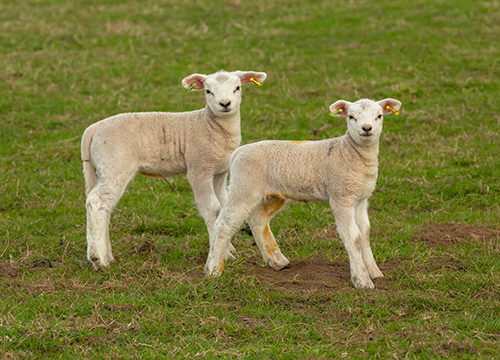Ensure a Profitable Operation During Lambing and Kidding Season
Apr 18, 2022

Written By Taylor Chavis, North Carolina Extension Agent
Breeding season for sheep and goats is usually September through January. The gestation period is five months, so does or ewes bred in September will be kidding/lambing in the next month or so. The profitability of goat and sheep operations depends on the number of kids and/or lambs raised, weaned, and marketed each year. Being prepared for kidding season can eliminate unnecessary stress and increase the chance of survival for the kids or lambs. To help ensure a profitable operation, keep a few things in mind during kidding/lambing season.
First, does/ewes’ nutritional needs change and affect the quality of colostrum, which is the first milk the kids/lambs need within the first 24 hours of life that provides immunity. Poor quality colostrum provides no protection and decreases survival rates tremendously. Does/ewes in the last 30 days of pregnancy as well as lactating does/ewes should be eating about 16% protein. Producers should start thinking about supplemental feeding if pasture hay is limited and of low quality. Facilities serve a vital role in housing the doe/ewe and kid/lamb. Pens should be clean and under a barn or shelter to protect them from harsh weather conditions. Winter/early spring kidding/lambing may require the use of a heat lamp, which should be in place if needed. Some producers choose to use “kid incubators” to rig up a heat lamp (made from 55-gallon plastic barrels with a hole cut out), so the lamp is away from the hay and the kid has access, but the doe cannot get in. Knowing the signs of dystocia (difficult birth) can help save both doe and kid.
The length of kidding can vary from 12 to 14 hours and consists of three stages: cervix dilation, the appearance of a water sac, and the birth of a kid. Once the water sac appears the kid should be born within 1 hour. If does/ewes appear to have difficulty pushing, producers can insert one hand inside the birth canal to determine the position of the kid and move if necessary. Does/ewes requiring assistance should be given an antibiotic afterward to prevent infection; seek a veterinarian for proper dosage.
After the birth, the first thing to do is make sure the kid is dry and has a chance to get colostrum. Often kids will die if they do not receive adequate colostrum. Producers should have supplemental colostrum on hand in case the doe will not nurse. A bottle or syringe can be used to feed the kid. Dip or spray the navel cord in iodine to prevent bacteria from entering the cord and causing infection. Kids can also be ear tagged. It is a good idea to keep a kidding/lambing kit that includes the following items: Ear-tags, record sheets, (herd notebook) Latex gloves, lubricant iodine feeding tube, and syringe colostrum supplement
To learn more visit: https://robeson.ces.ncsu.edu/2020/01/kidding-lambing-season/
Breeding season for sheep and goats is usually September through January. The gestation period is five months, so does or ewes bred in September will be kidding/lambing in the next month or so. The profitability of goat and sheep operations depends on the number of kids and/or lambs raised, weaned, and marketed each year. Being prepared for kidding season can eliminate unnecessary stress and increase the chance of survival for the kids or lambs. To help ensure a profitable operation, keep a few things in mind during kidding/lambing season.
First, does/ewes’ nutritional needs change and affect the quality of colostrum, which is the first milk the kids/lambs need within the first 24 hours of life that provides immunity. Poor quality colostrum provides no protection and decreases survival rates tremendously. Does/ewes in the last 30 days of pregnancy as well as lactating does/ewes should be eating about 16% protein. Producers should start thinking about supplemental feeding if pasture hay is limited and of low quality. Facilities serve a vital role in housing the doe/ewe and kid/lamb. Pens should be clean and under a barn or shelter to protect them from harsh weather conditions. Winter/early spring kidding/lambing may require the use of a heat lamp, which should be in place if needed. Some producers choose to use “kid incubators” to rig up a heat lamp (made from 55-gallon plastic barrels with a hole cut out), so the lamp is away from the hay and the kid has access, but the doe cannot get in. Knowing the signs of dystocia (difficult birth) can help save both doe and kid.
The length of kidding can vary from 12 to 14 hours and consists of three stages: cervix dilation, the appearance of a water sac, and the birth of a kid. Once the water sac appears the kid should be born within 1 hour. If does/ewes appear to have difficulty pushing, producers can insert one hand inside the birth canal to determine the position of the kid and move if necessary. Does/ewes requiring assistance should be given an antibiotic afterward to prevent infection; seek a veterinarian for proper dosage.
After the birth, the first thing to do is make sure the kid is dry and has a chance to get colostrum. Often kids will die if they do not receive adequate colostrum. Producers should have supplemental colostrum on hand in case the doe will not nurse. A bottle or syringe can be used to feed the kid. Dip or spray the navel cord in iodine to prevent bacteria from entering the cord and causing infection. Kids can also be ear tagged. It is a good idea to keep a kidding/lambing kit that includes the following items: Ear-tags, record sheets, (herd notebook) Latex gloves, lubricant iodine feeding tube, and syringe colostrum supplement
To learn more visit: https://robeson.ces.ncsu.edu/2020/01/kidding-lambing-season/